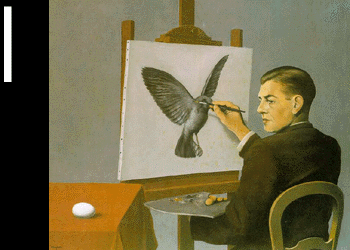In the postmodern scheme of things, the old saying ‘A picture is worth a thousand words’ takes on a whole new meaning. It is not so much what those thousand words are that the picture intends to convey, but rather what the thousand responses it evokes. Be it a painting, a film, or a literary work, all have the potential to elicit a myriad of responses, reactions as varied as each individual life lived.
Some ready examples can be found in Ripple Effects’ comment sections. On a post about a movie I highly recommended, a reader responded that she had fallen asleep while watching it. Or, take the Edward Hopper paintings. While I found the phrase ‘existential loneliness’ to be an apt description for his works Nighthawk and Automat, a commenter expressed a sense of coziness and quiet content as her response to these paintings. Conversely, while I perceive Cape Cod Morning as anticipatory with positive excitement, the commenter sees “a woman trapped, caught in frustration or even despair, longing to move into the world but still constrained inside the structures of her life.”

There had been readers’ responses in the past long before the computer age. But what we have now is nothing short of phenomenal. The Internet has enabled us to share and exchange our very personal reaction to a single source material simultaneously, allowing multiple voices to resound instantaneously from all corners of the world. Every voice has the potential to call forth attention, every subjectivity can be equally amplified. Reader’s response is thus given a heightened significance.
From this perspective then, the reality of a piece of writing, or artwork, seems to have shifted from the author to the reader, or the artist to the viewer, for it is the recipient now that speaks to the work, giving it meaning and application.
Should we still be concerned with the original intent of the piece? Is it mere speculation to discuss about it, while in the mean time, it is more real and substantial to talk about what our response is, our own personal engagement with it? Further, instead of focusing on one intended interpretation, should we explore rather the multiplicity of interpretations elicited from readers’ own perspectives and experiences?
Writing before the rise of the Internet, the French literary critic Roland Barthes put it most starkly in his essay “The Death of the Author”:
“… a text is made of multiple writings, drawn from many cultures and entering into mutual relations of dialogue, parody, contestation, but there is one place where this multiplicity is focused and that place is the reader, not, as was hitherto said, the author. The reader is the space on which all the quotations that make up a writing are inscribed without any of them being lost; a text’s unity lies not in its origin but in its destination…”
and a warning here, the language used in the following excerpt may be objectionable to some:
“Classic criticism has never paid any attention to the reader; for it, the writer is the only person in literature. We are now beginning to let ourselves be fooled no longer by the arrogant antiphrastical recriminations of good society in favor of the very thing it sets aside, ignores, smothers or destroys; we know that to give writing its future, it is necessary to overthrow the myth: the birth of the reader must be at the cost of the death of the Author.”
The postmodern theorist Michel Foucault wraps it up succinctly:
“What difference does it make who is speaking?”
The listener seems to have taken up a much more significant role these days.
Our postmodern literary theorists have thus spoken: The author is dead, long live the reader, and the words.
This idea may not sound so radical, for similar notions have been expressed. Instead of an all-knowing authority, the author is more like a recorder of a tale, the scribe writing down the oracle. The Canadian writer Michael Ondaatje’s words come to mind. Even as an author, it seems his creative process is one that awaits the revealing of his story, capturing it in words as it unfolds itself:
“I don’t know what would happen… I don’t want to know.”
Further, Ondaatje welcomes the multiplicity of interpretations. In his discussion with film editor Walter Murch, he addresses this issue in a positive light:
“We are not held hostage by just one certain story, or if we are, we know it is just one opinion: there are clear hints of other versions.” — The Conversations, p. 160.
Multiplicity enhances and enriches a scene. That is the amiable way of putting it, while Barthes is more matter-of-fact in pointing out where meaning and significance lie:
“… it is language which speaks, not the author.”
In a way, such a perspective could be a much-needed humbling reminder in our too crazed, celebrity-driven culture.
But for those of us who strive with all earnestness and honesty to instill meaning in our writing, who have been meticulous and intentional in our craft and guarding its integrity as we create, when we speak, don’t we wish someone out there would receive our message accurately, as it is intended?
Why do we write, or create anyway? Do we want our readers to know about us or just to hear the words we happen to utter? Further, shouldn’t we be concerned that what we elicit could well be interpretations far from what we have intended to get across? How do we balance author’s intent with readers’ response?
Simple questions, but ones which I’m sure can elicit a thousand responses.
To read Roland Barthes’s essay ‘The Death of the Author’, Click Here.
To read Michel Foucault’s essay ‘What Is an Author’, Click Here.
Visual: ‘Self Portrait’ by René Magritte, 1936.
